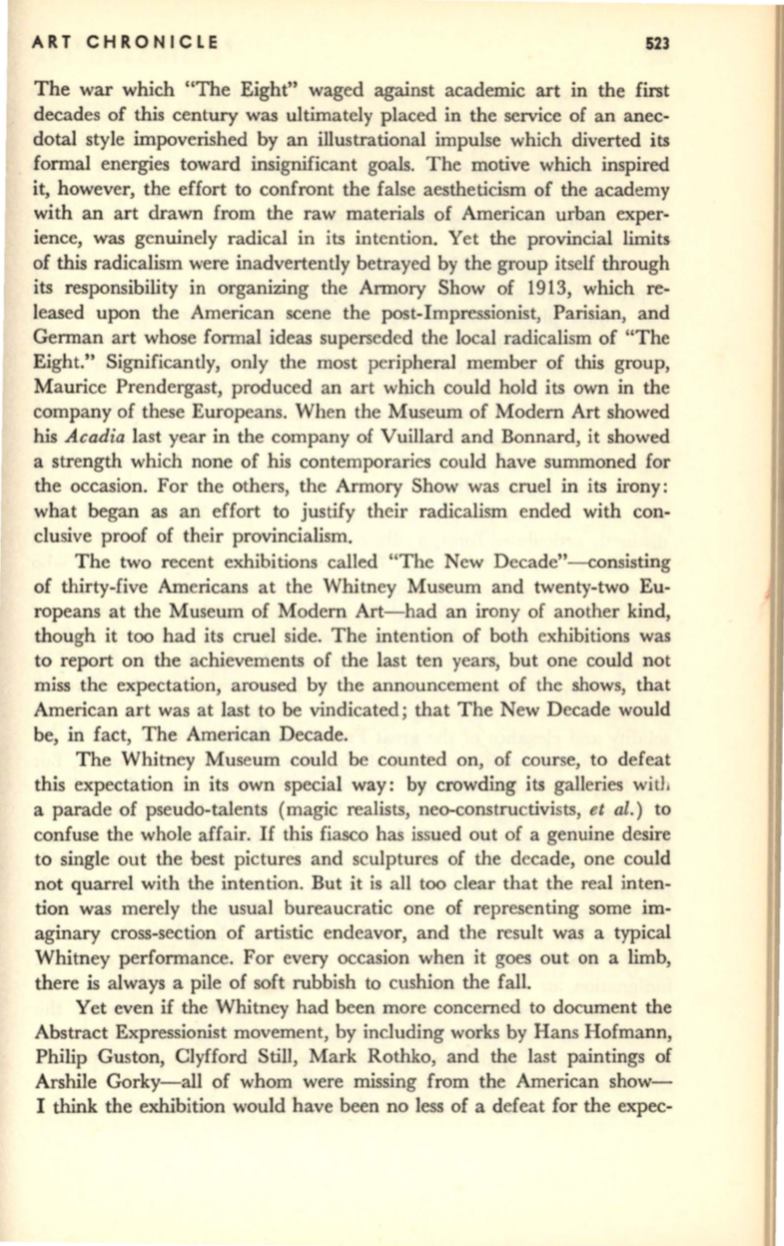
ART CHRONICLE
523
The war which "The Eight" waged against academic art in the first
decades of this century was ultimately placed in the service of an anec–
dotal style impoverished by an illustrational impulse which diverted its
formal energies toward insignificant goals. The motive which inspired
it, however, the effort to confront the false aestheticism of the academy
with an art drawn from the raw materials of American urban exper–
ience, was genuinely radical in its intention. Yet the provincial limits
of this radicalism were inadvertently betrayed by the group itself through
its responsibility in organizing the Armory Show of 1913, which re–
leased upon the American scene the post-Impressionist, Parisian, and
German art whose formal ideas superseded the local radicalism of "The
Eight." Significantly, only the most peripheral member of this group,
Maurice Prendergast, produced an art which could hold its own in the
company of these Europeans. When the Museum of Modem Art showed
his
Acadia
last year in the company of Vuillard and Bonnard, it showed
a strength which none of his contemporaries could have summoned for
the occasion. For the others, the Armory Show was cruel
in
its irony:
what began as an effort to justify their radicalism ended with con–
clusive proof of their provincialism.
The two recent exhibitions called "The New Decade"---consisting
of thirty-five Americans at the Whitney Museum and twenty-two Eu–
ropeans at the Museum of Modem Art-had an irony of another kind,
though it too had its cruel side. The intention of both exhibitions was
to report on the achievements of the last ten years, but one could not
miss the expectation, aroused by the announcement of the shows, that
American art was at last to be vindicated; that The New Decade would
be, in fact, The American Decade.
The Whitney Museum could be counted on, of course, to defeat
this expectation in its own special way: by crowding its galleries witli
a parade of pseudo-talents (magic realists, neo-constructivists,
et al.)
to
confuse the whole affair.
If
this fiasco has issued out of a genuine desire
to single out the best pictures and sculptures of the decade, one could
not quarrel with the intention. But it is all too clear that the real inten–
tion was merely the usual bureaucratic one of representing some im–
aginary cross-section of artistic endeavor, and the result was a typical
Whitney performance. For every occasion when it goes out on a limb,
there is always a pile of soft rubbish to cushion the fall.
Yet even if the Whitney had been more concerned to document the
Abstract Expressionist movement, by including works by Hans Hofmann,
Philip Guston, Clyfford Still, Mark Rothko, and the last paintings of
Arshile Gorky-all of whom were missing from the American show–
I think the exhibition would have been no less of a defeat for the expec-


